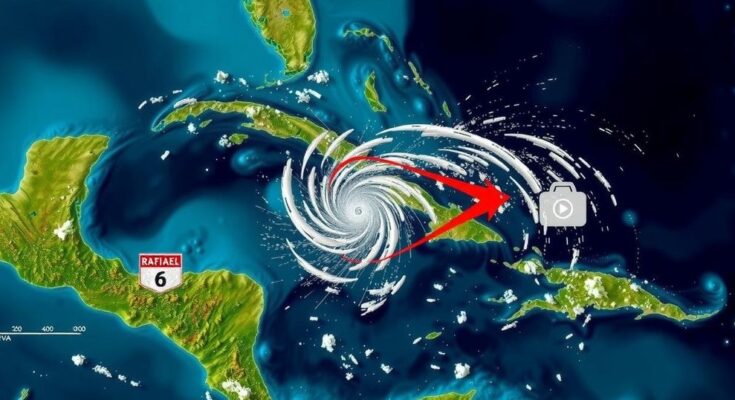Hurricane Rafael, now a Category 2 storm, is forecasted to move west across the Gulf of Mexico, facing conditions that could weaken it to a tropical storm by Sunday. The storm previously impacted Cuba as a Category 3 hurricane, causing electrical outages. There is a low chance of a new tropical disturbance forming in the eastern Caribbean over the coming days.
Hurricane Rafael, currently classified as a Category 2 storm, is projected to navigate westward across the Gulf of Mexico over the upcoming days. The storm is anticipated to encounter unfavorable conditions, including significant wind shear, dry air, and cooler water temperatures, which may gradually diminish its intensity. Forecasts from the National Hurricane Center indicate that by the time Rafael approaches Mexico on Sunday, it could potentially downgrade to a tropical storm. As of the latest update on Thursday at 7 a.m., the tropical storm warning for the Dry Tortugas has been lifted, and no additional warnings or watches are in effect. However, meteorologists have cautioned that the storm may still generate hazardous surf and rip current conditions across the Gulf, posing life-threatening risks. Rafael made landfall in western Cuba on Wednesday as a Category 3 hurricane, causing significant damage to the nation’s already struggling electrical infrastructure. This is particularly concerning in light of the recent Hurricane Oscar, which impacted Cuba in October, resulting in fatalities and extensive property damage. Additionally, the hurricane center has downgraded the likelihood of a new tropical disturbance forming north of Puerto Rico and Haiti, stating there is only a 20% chance that it may evolve into a tropical depression within the next week. The upcoming storm name following Rafael is Sara.
The Atlantic hurricane season engages various atmospheric and oceanic factors that contribute to storm formation and intensification. Hurricanes pose significant threats to coastal regions, with potential impacts including strong winds, heavy rainfall, and devastating storm surges. The recent trajectory of Hurricane Rafael highlights the challenges posed during such meteorological events, particularly for vulnerable regions in the Caribbean and Gulf of Mexico. Understanding these weather patterns is crucial for preparedness and response efforts.
In summary, Hurricane Rafael is expected to progress westward across the Gulf of Mexico while facing conditions likely to weaken it to a tropical storm by the time it reaches Mexico. The recent impact on Cuba underscores the ongoing challenges posed by hurricanes in the region, leading to infrastructure damages and safety hazards across the Gulf. As forecasters continue to monitor Rafael, awareness and preparedness remain essential to mitigate potential risks to life and property.
Original Source: www.tampabay.com




